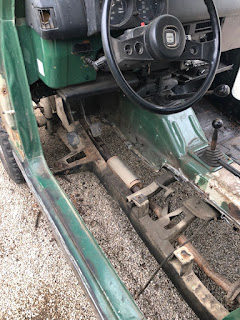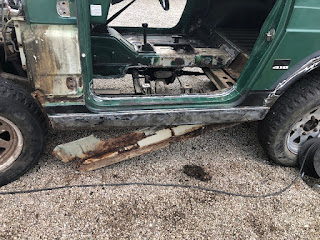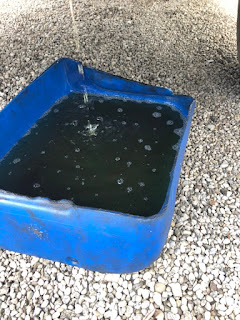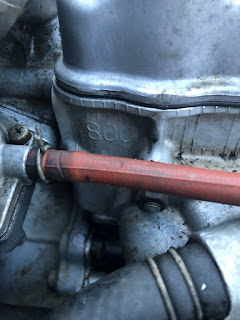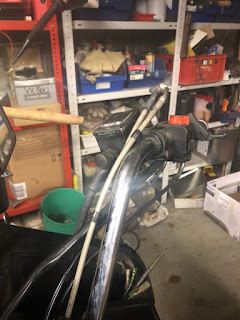Let's say you have a simple and mechanically robust vehicle and around 10 years after the production ended only a very limited number of those are still on the road. As breakdowns and crashes only play an insignificant role, there's just one potential explanation left with these cars: rust. Whilst built to a very Japanese standard (especially if compared to let's say a Lada Niva), there's a few rust traps, which just have to rust out and then there's the fact that these were rather cheap to begin with...
Yes, that's yours truly inside the little Suzuki without floors, doing my finest Fred Flintstone impression. But I hear you: didn't you say that it wasn't such a bad car to start with? I did and maybe I was simply wrong. One could probably even have rolled with some of the bodges shown over the course of this post and probably a few more coming up in the coming weeks.
After establishing that the floorpans where a collection of patches stacked on top of more patches and going from a first casual inspection to looking at stuff closer, it became apparent that not only the floorpans, but also the foot well and the inner sill would need replacing. A few rust spots on the transmission tunnel complimented the left side rather nicely.
So as a first step, get the doors out of the way. The JIS-bolts wanted a good, old fashioned tap with the manual impact to come out, but didn't exactly put up a fight.
The sealant did its job very, very well, with the bare metal not even showing traces of rust.
With the front fenders off, one encounters a recurring theme on this car: Why bother with cutting out the rust, when you can put on a sheet of roofing tin and patch it up for another year? ... and the next year do it all again, leading to what I have dubbed the "croissant effect".
Peeling back layer after layer, one reaches the original metal, which quite frankly would have been pretty simple to repair twenty years ago - but the nice thing is: it's still quite doable as the repair panels are readily available.* (* which isn't quite true as I later found out, as the repair panels for
Samurais and 413s are available, yet not for the early 410 with the
narrow gearbox tunnel like this one... )
With it rapidly becoming being apparent that this wouldn't be the quick cosmetic job I anticipated, I tackled the driver side floor pan. Or should I say pans? He did use some nice thick sheet metal though.
Admittedly seeing the car without a driver-side floorpan was a bit disheartening.
On top of that this was the first mistake I made: instead of cutting out the floorpan and then drilling out the remaining spot welds, I should have drilled all of them out first and then do some relieve cuts if necessary, because to put it very mildly, things get quite floppy, with no floorpan around.
Say what you will, the last guy was a massive supporter of the local steel mill.
Admittedly I was close to forgiving him his sins and if it was for the mere fact that he tried to keep the old girl on the road. Until I saw this: Well if your frame mount is too rotten, what do you do? That's right, pidgeon-shit weld a bit of sheet metal to the frame and the sill and then cover it up with 5 layers of steel. Ironically this would have been one hell of a showstopper, if I had gone ahead and separated the body from the frame as is common practice on these old Suzukis.
With this out of the way, I was finally able to remove the inner sill (at this point I still thought that the outer sill would be salvageable).
As a matter of fact this side didn't look too bad and definitely not bad enough to warrant a nearly two hundred Euro patch panel.
... and with this one, let's finish the first post on the rusty side of things. (There will be a few more no worries!) To this date, it's been approximately five weeks of cutting out rusty sheetmetal (started on February 28th) and only some minor fixes to the transmission tunnel and a few panels where the angle grinder veered off course.









